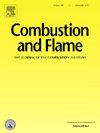氧化液体核壳铁粒子内部传输的数值研究
IF 5.8
2区 工程技术
Q2 ENERGY & FUELS
引用次数: 0
摘要
为了更好地理解液态铁粒子燃烧的限速机制,本研究调查了核壳结构内部传输的影响。对之前发表的论文(Thijs 等人,2023 年)中提出的二维轴对称瞬态连续模型进行了扩展,从而解决了颗粒与气体之间的边界层、颗粒与气体界面的表面过程以及颗粒内部的氧化层(考虑到活性 O 和铁离子的传输)问题。作为补充数据的平衡相图信息用于确定粒子的氧化率。研究表明,与假设无限快传输的模型相比,有限速率内部传输会显著改变温度的演变。在氧气浓度升高时,内部传输成为速率限制,从而限制了颗粒的最高温度。核壳假设导致颗粒与气体界面的局部氧化度高于颗粒内的平均氧化度,从而降低了整体氧气消耗率。当热量损失超过热量释放时,就会达到颗粒的最高温度。虽然内部传输限制了最高温度,但初始加热速率仍然被高估,这表明初始阶段并不完全受外部氧气扩散的限制,L2-气体表面也没有达到热力学平衡。该模型没有解释某些实验中观察到的颗粒大小对最高温度的影响。一种假设的解释是,内部对流在较大颗粒中更为明显,可能会减少内部传输限制,从而导致较大颗粒中的最高温度升高。新颖性和意义这项研究通过数值研究核壳结构内部传输的影响,推进了对液态铁颗粒燃烧中氧化率限制机制的理解。通过使用二维轴对称瞬态连续模型,研究揭示了有限速率内部传输会显著影响氧化微米级铁粒子的温度演变,尤其是在氧气浓度升高时,内部传输会成为速率限制因素。研究结果表明,有限速率内部传输会导致颗粒与气体界面的局部氧化程度升高,从而降低耗氧率。研究强调,有限速率内部传输限制了氧气浓度升高时颗粒的最高温度,这是在孤立铁颗粒燃烧实验中观察到的趋势。此外,这项研究还为实验观察到的颗粒大小对最大颗粒温度的影响提供了一种假设性解释,强调了内部对流在较大颗粒中的作用。本文章由计算机程序翻译,如有差异,请以英文原文为准。
A numerical study of internal transport in oxidizing liquid core–shell iron particles
In an effort to improve the understanding of the rate-limiting mechanisms in liquid iron particle combustion, this study investigates the impact of internal transport within a core–shell structure. The two-dimensional axisymmetric transient continuum model as presented in previous publication (Thijs et al., 2023) is extended, such that the boundary layer between the particle and the gas, surface processes at the particle–gas interface, as well as the internal oxide layer within the particle, considering the transport of reactive O and Fe ions, are resolved. Information from the equilibrium phase diagram, which is included as supplementary data, is used to determine oxidation rate of the particle. The study reveals that finite-rate internal transport significantly alters the temperature evolution compared to models assuming infinitely fast transport. At elevated oxygen concentrations, internal transport becomes rate-limiting, restricting the maximum particle temperature. The core–shell assumption leads to a higher local oxidation degree at the particle–gas interface than the average in the particle, reducing the overall oxygen consumption rate. The maximum particle temperature is reached when heat loss exceeds heat release. Although internal transport limits the maximum temperature, the initial heating rate remains overestimated, suggesting that the initial phase is not solely limited by external oxygen diffusion, and the L2-gas surface is not at thermodynamic equilibrium. The model does not account for the particle size effect on maximum temperature as observed in some experiments. A hypothetical explanation is that internal convection, more pronounced in larger particles, may reduce the internal transport limitation, leading to higher maximum temperatures in larger particles.
Novelty and significance
This study advances the understanding of oxidation rate-limiting mechanisms in liquid iron particle combustion by numerically investigating the impact of internal transport within a core–shell structure. By using a two-dimensional axisymmetric transient continuum model, the research reveals that finite-rate internal transport significantly affects temperature evolution of an oxidizing micron-sized iron particle, particularly at elevated oxygen concentrations where it becomes rate-limiting. The findings demonstrate that a finite-rate internal transport leads to a higher local oxidation degree at the particle–gas interface, reducing the oxygen consumption rates. The study highlights that finite-rate internal transport limits the maximum particle temperature at elevated oxygen concentrations, a trend observed in isolated iron particle combustion experiments. Furthermore, this study provides a hypothetical explanation for the experimentally observed particle size effects on the maximum particle temperature, emphasizing the role of internal convection in larger particles
求助全文
通过发布文献求助,成功后即可免费获取论文全文。
去求助
来源期刊

Combustion and Flame
工程技术-工程:化工
CiteScore
9.50
自引率
20.50%
发文量
631
审稿时长
3.8 months
期刊介绍:
The mission of the journal is to publish high quality work from experimental, theoretical, and computational investigations on the fundamentals of combustion phenomena and closely allied matters. While submissions in all pertinent areas are welcomed, past and recent focus of the journal has been on:
Development and validation of reaction kinetics, reduction of reaction mechanisms and modeling of combustion systems, including:
Conventional, alternative and surrogate fuels;
Pollutants;
Particulate and aerosol formation and abatement;
Heterogeneous processes.
Experimental, theoretical, and computational studies of laminar and turbulent combustion phenomena, including:
Premixed and non-premixed flames;
Ignition and extinction phenomena;
Flame propagation;
Flame structure;
Instabilities and swirl;
Flame spread;
Multi-phase reactants.
Advances in diagnostic and computational methods in combustion, including:
Measurement and simulation of scalar and vector properties;
Novel techniques;
State-of-the art applications.
Fundamental investigations of combustion technologies and systems, including:
Internal combustion engines;
Gas turbines;
Small- and large-scale stationary combustion and power generation;
Catalytic combustion;
Combustion synthesis;
Combustion under extreme conditions;
New concepts.
 求助内容:
求助内容: 应助结果提醒方式:
应助结果提醒方式:


